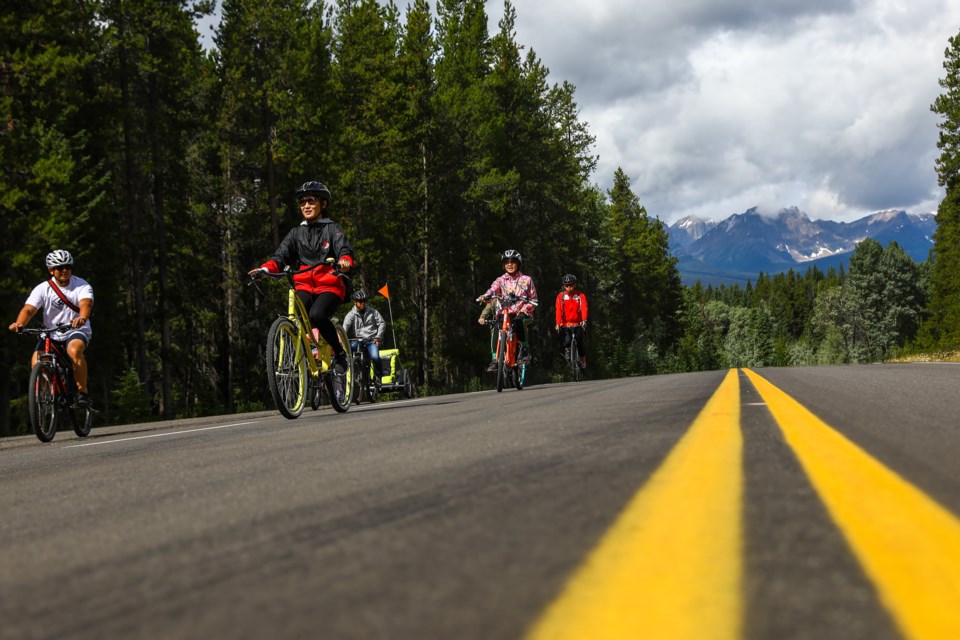BANFF – The Canadian Parks and Wilderness Society (CPAWS) is conducting a survey to get visitors’ thoughts on the vehicle closure of the eastern portion of the Bow Valley Parkway.
CPAWS, which has called on Parks Canada to develop a human use management strategy for Banff National Park, says the survey results will contribute to broader discussions as part of the current review of the park management plan.
Sarah Elmeligi, who works as a consultant for CPAWS on national park issues, said one of the organization’s principle recommendations is that Parks Canada commit to the creation of a human use strategy to improve visitor management in the busy park.
“It is essential this strategy is based on data rather than assumption, yet there is a lack of social science in Parks Canada’s existing monitoring efforts,” she said.
“The results from this survey will be used by CPAWS and its partners to inform specific management recommendations pertaining to human use management in Banff National Park.”
Parks Canada put the vehicle closure in place from the Fireside day-use area to Castle Junction for the summer in response to the COVID-19 pandemic when the park reopened in June.
The survey has six core objectives – to determine what recreational activities visitors are doing on the parkway; to measure support for the vehicle closure; to measure visitors’ satisfaction with their experience; to determine visitor support for continuing these types of management measures beyond the COVID-19 pandemic; and to determine how much the current road closure contributed to visitors’ motivation to visit the park and recreate on the parkway.
Lastly, the questionnaire also aims to measure support for various human use management tools that may be applied in other tourist hot spots in Banff National Park, which attracts more than four million visitors a year.
“This survey is our way of trying to get the ball rolling on collecting some human use data and more meaningful visitor perception data,” said Elmeligi.
The vehicle closure of the Bow Valley Parkway this summer would unlikely have happened had it not been for Parks Canada’s management of COVID-19.
“COVID has presented us with an opportunity to implement management actions that we never would have had the social support to implement,” said Elmeligi.
“Now we can actually test how people feel about it in reality instead of hypothetically.”
The CPAWS survey has nothing to do with Parks Canada’s annual springtime overnight closure of a 17-km stretch of the parkway east of Johnston Canyon campground, which runs each year from March 1 to June 25.
“That closure is specifically for wolf and grizzly bear habitat security during a really critical time of year,” said Elmeligi, noting CPAWS has always supported that seasonal closure.
“But the Bow Valley Parkway still has critical habitat for wolves and grizzly bears throughout the summer, and we know reducing vehicle traffic increases habitat security for carnivores.”
In terms of future access and vehicular management on the parkway, the Bow Valley Naturalists (BVN) have long had recommendations for the area.
BVN suggests Parks Canada consider implementing its ideas from the former Bow Valley Parkway working group, one of which was to close the eastern portion of the 1A to private motor vehicles and maintaining facility access via foot, bicycle and transit.
“That said, we think it’s important that everyone understands that there is no ‘free lunch,’ ” said Reg Bunyan, a spokesperson BVN.
“Human use, including how many visitors, what they do and when and where they visit, is a very complex issue, made even more complex by Parks Canada’s reluctance to consider visitation limits.”
In addition, Bunyan said management decisions or restrictions in one area may have significant adverse impacts on other areas.
“It’s important that any future decision on the 1A not be made in isolation from other ecological considerations such as parking and visitor use impacts created elsewhere,” he said.
Parks Canada officials say the current vehicle restriction on the parkway supports physical distancing at the popular Johnston Canyon trail, where narrow sections make keeping two metres apart from each other challenging.
“The vehicle restriction on the Bow Valley Parkway will remain in place until the fall, at which time Parks Canada will reassess the situation and determine next steps,” said David Dunbar, a spokesperson for Banff National Park.
“Public safety is the top priority in determining if and when Parks Canada places and activities should resume or reopen, and this will only be done where and when it is safe to do so.”
Dunbar said the vehicle restriction on the parkway provides an exceptional opportunity for visitors to cycle in Banff National Park.
He said Parks Canada does not count the number of cyclists on the parkway.
“However, since the reopening of some services on June 1, there has been steady pedal traffic starting at the east entrance of the parkway,” said Dunbar.
Meanwhile, Parks Canada has postponed public consultations and formal engagement on the Banff National Park management plan until further notice due to COVID-19.
“Parks Canada is committed to resuming all management planning activities, including public consultations and formal engagement with stakeholders and Indigenous peoples once it is safe to do so,” said Dunbar.
“It is too soon to say exactly what that might look like and how it will be done, but it is likely that online engagement, as always, will be a key tool in reaching Canadians across the country.”
The CPAWS survey runs until Sept. 30.




